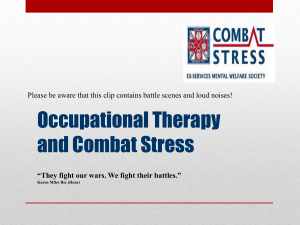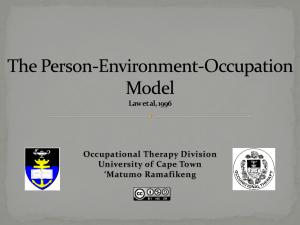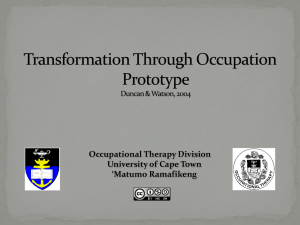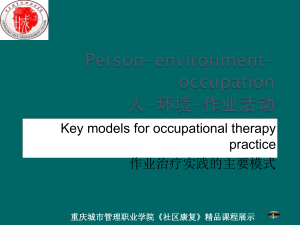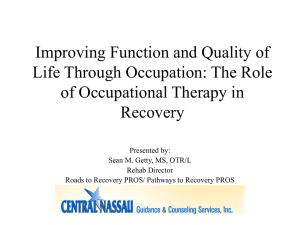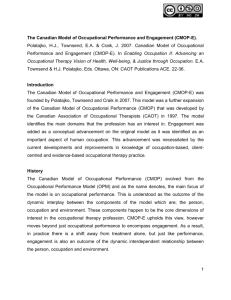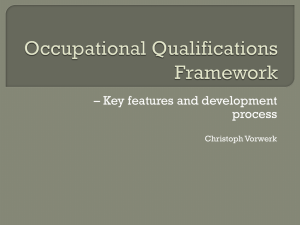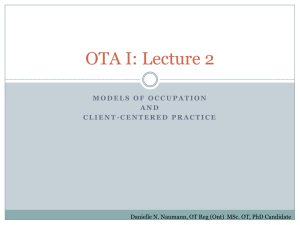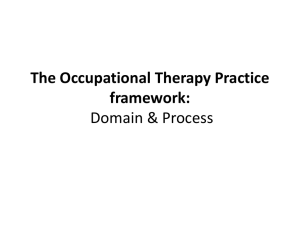The Canadian Model of Occupational Performance and
advertisement
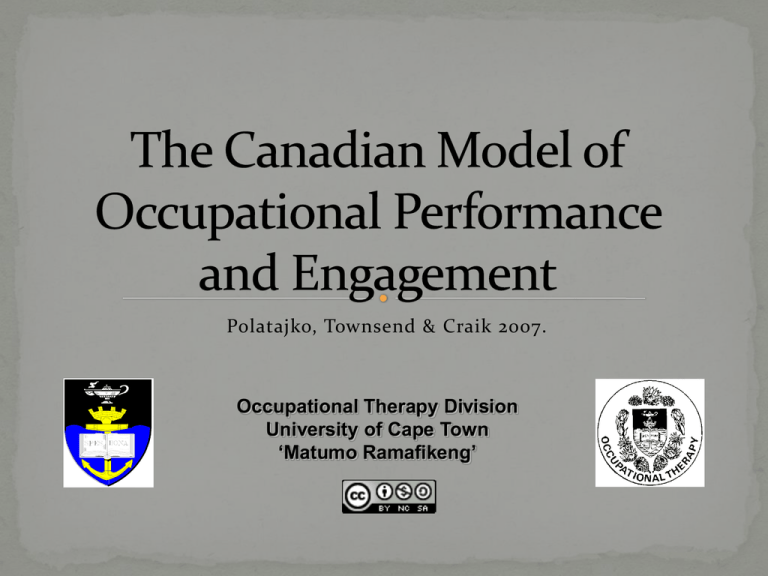
Polatajko, Townsend & Craik 2007. Occupational Therapy Division University of Cape Town ‘Matumo Ramafikeng’ Developed from the Canadian Model of Occupational Performance (CMOP) Captures the occupational perspective of human occupation Positions profession beyond the medical model Envisions health, well-being and justice as attainable through occupation Introduces engagement as an important construct in understanding human occupation Based on shared assumptions of the profession Client-centredness is key Humanistic theories- client centred principles Developmental theories- adaptation and development of occupational roles Environmental theories- the influence of environment on occupation and the person Occupational performance Occupational Engagement Both are a result of a dynamic interaction between components of the model. Presents a transverse view of model that situates occupation as the core focus of the profession. Refers to all that people do to become occupied Speaks to occupying self or others Relates to having occupations and not only performing them Presents a broader view of human occupation Figure 1. The CMOP-E1: Specifying our domain of concern (Used with permission from CAOT Publications ACE) A.1 Referred to as CMOP in Enabling Occupation in previous editions (1997 and 2002) and CMOP-E as of the 2007 edition (Polatajko et al., 2007) B. Trans-sectional view Person Occupation Environment Made up of three performance components: 1. 2. 3. Cognitive Affective Physical With spirituality as the core of the person • Presents occupational opportunities • Environmental influences are classified as: 1. 2. 3. 4. Physical Cultural Social Institutional Link between the person and the environment Vehicle that enables acting on the environment Made up of three occupational areas: 1. 2. 3. Self-care Productivity Leisure Change in one component= change in another component Limitations within the person= decreased performance An unsupportive environment= decreased performance and engagement Limited occupational opportunities= limited occupational engagement Harmonious relationship between components= optimal performance and engagement Allows for use with other frameworks. Can be used across age groups. Can be applied to various diagnoses. Promotes client-centredness. Can be used in multicultural settings. Congruent with the International Classification of Functioning, Disability and Health (ICF). Directs focus of practice on creating environments that are occupationally supportive Means through which health and well-being may be attained. Clarke, C. 2003. Clinical application of the Canadian Model of Occupational Performance in a forensic rehabilitation hostel. British Journal of Occupational Therapy. 66(4)171-174. Grant, D.D. & Lundon, K. 1998. The Canadian Model of Occupational Performance applied to females with osteoporosis. Canadian Journal of Occupational Therapy. 66(4)3-12. Polatajko, H.J., Townsend, E.A. & Craik, J. 2007. Canadian Model of Occupational Performance and Engagement (CMOP-E). In Enabling Occupation II: Advancing an Occupational Therapy Vision of Health, Well-being, & Justice through Occupation. E.A. Townsend & H.J. Polatajko, Eds. Ottawa, ON: CAOT Publications ACE. 22-36. World Health Organization. 2001. International Classification of Functioning, Disability and Health. Geneva: WHO. This work is licensed under the Creative Commons Attribution-Non CommercialShare Alike 2.5 South Africa License. To view a copy of this license, visit http://creativecommons.org/licenses/bysa/2.5/za/
